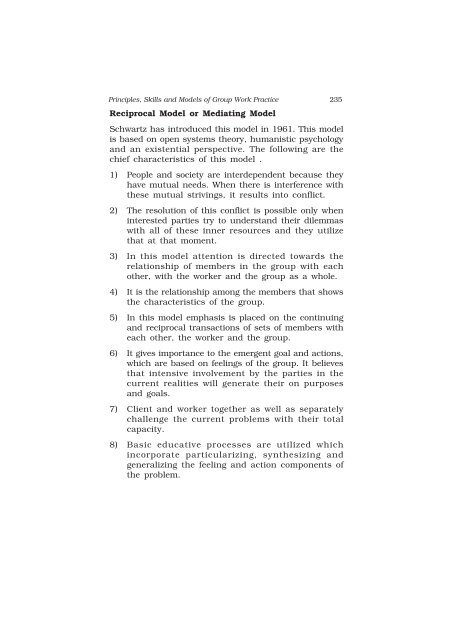Principles, Skills and Models of Group Work Practice - IGNOU
Principles, Skills and Models of Group Work Practice - IGNOU Principles, Skills and Models of Group Work Practice - IGNOU
Principles, Skills and Models of Group Work Practice 235 Reciprocal Model or Mediating Model Schwartz has introduced this model in 1961. This model is based on open systems theory, humanistic psychology and an existential perspective. The following are the chief characteristics of this model . 1) People and society are interdependent because they have mutual needs. When there is interference with these mutual strivings, it results into conflict. 2) The resolution of this conflict is possible only when interested parties try to understand their dilemmas with all of these inner resources and they utilize that at that moment. 3) In this model attention is directed towards the relationship of members in the group with each other, with the worker and the group as a whole. 4) It is the relationship among the members that shows the characteristics of the group. 5) In this model emphasis is placed on the continuing and reciprocal transactions of sets of members with each other, the worker and the group. 6) It gives importance to the emergent goal and actions, which are based on feelings of the group. It believes that intensive involvement by the parties in the current realities will generate their on purposes and goals. 7) Client and worker together as well as separately challenge the current problems with their total capacity. 8) Basic educative processes are utilized which incorporate particularizing, synthesizing and generalizing the feeling and action components of the problem.
236 Social Work Intervention with Individuals and Groups 9) In this model distinctions are not made with respect to types and various of group since it is presumed that this model is widely applicable. In this model the individual and the group are significant components. The workers role appears to be facilitative, relying on the power and potency of mutual aid system to take care of itself. Developmental Model This model has been developed by the faculty members of Boston University under the leadership of Berustein in 1965. Lowy is the main architect of the developmental model. In this approach, groups are seen as having “a degree of independence and autonomy, but the to and fro flow between them and their members, between them and their social settings, is crucial to their existence, viability and achievements. The chief characteristics of this model are: 1) It is primarily based on the dynamics of intimacy and closeness between the members over a span of time. 2) The degree of intimacy is taken into account for appropriate worker interventions. 3) Conceptualization of study, diagnosis and treatment is made at all three levels of individuals, group and the setting. 4) This model derives knowledge from Erikson’s ego psychology, group dynamics and conflict theory. 5) The group worker is engaged in study, diagnosis and treatment. 6) The worker is connected with community, agency, group and individual member.
- Page 1 and 2: 212 Social Work Intervention with I
- Page 3 and 4: 214 Social Work Intervention with I
- Page 5 and 6: 216 Social Work Intervention with I
- Page 7 and 8: 218 Social Work Intervention with I
- Page 9 and 10: 220 Social Work Intervention with I
- Page 11 and 12: 222 Social Work Intervention with I
- Page 13 and 14: 224 Social Work Intervention with I
- Page 15 and 16: 226 Social Work Intervention with I
- Page 17 and 18: 228 Social Work Intervention with I
- Page 19 and 20: 230 Social Work Intervention with I
- Page 21 and 22: 232 Social Work Intervention with I
- Page 23: 234 Social Work Intervention with I
- Page 27 and 28: 238 Social Work Intervention with I
- Page 29 and 30: 240 Social Work Intervention with I
<strong>Principles</strong>, <strong>Skills</strong> <strong>and</strong> <strong>Models</strong> <strong>of</strong> <strong>Group</strong> <strong>Work</strong> <strong>Practice</strong> 235<br />
Reciprocal Model or Mediating Model<br />
Schwartz has introduced this model in 1961. This model<br />
is based on open systems theory, humanistic psychology<br />
<strong>and</strong> an existential perspective. The following are the<br />
chief characteristics <strong>of</strong> this model .<br />
1) People <strong>and</strong> society are interdependent because they<br />
have mutual needs. When there is interference with<br />
these mutual strivings, it results into conflict.<br />
2) The resolution <strong>of</strong> this conflict is possible only when<br />
interested parties try to underst<strong>and</strong> their dilemmas<br />
with all <strong>of</strong> these inner resources <strong>and</strong> they utilize<br />
that at that moment.<br />
3) In this model attention is directed towards the<br />
relationship <strong>of</strong> members in the group with each<br />
other, with the worker <strong>and</strong> the group as a whole.<br />
4) It is the relationship among the members that shows<br />
the characteristics <strong>of</strong> the group.<br />
5) In this model emphasis is placed on the continuing<br />
<strong>and</strong> reciprocal transactions <strong>of</strong> sets <strong>of</strong> members with<br />
each other, the worker <strong>and</strong> the group.<br />
6) It gives importance to the emergent goal <strong>and</strong> actions,<br />
which are based on feelings <strong>of</strong> the group. It believes<br />
that intensive involvement by the parties in the<br />
current realities will generate their on purposes<br />
<strong>and</strong> goals.<br />
7) Client <strong>and</strong> worker together as well as separately<br />
challenge the current problems with their total<br />
capacity.<br />
8) Basic educative processes are utilized which<br />
incorporate particularizing, synthesizing <strong>and</strong><br />
generalizing the feeling <strong>and</strong> action components <strong>of</strong><br />
the problem.



